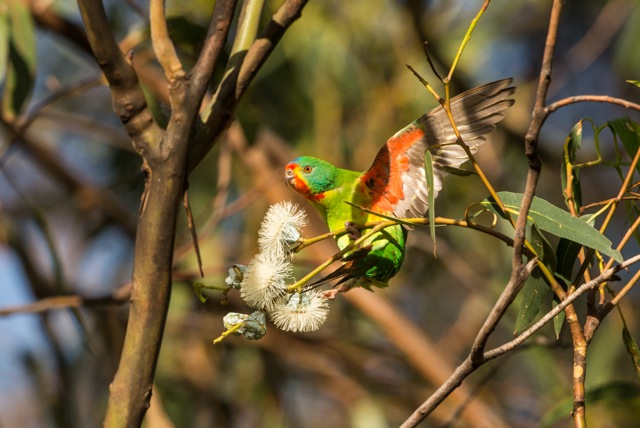The Tasmanian government has again drawn the ire of conservationists after documents obtained by The Wilderness Society emerged yesterday revealing it had disengaged with the body established to save the endangered Swift Parrot while continuing to log key habitat.
The record-breaking bird flies the farthest of any parrot species for love – migrating as far as southern Queensland before returning to Tasmania each year to breed – but just 2,000 individuals remain.
Scientists estimate that, at current rates, the species’ numbers could suffer a 94 per cent collapse within 16 years if the logging doesn’t end.
But the Liberal government in Tasmania has enthusiastically approved the logging of key habitat, which is the greatest threat to the Swift Parrot’s ongoing survival, while The Wilderness Society has revealed the Hodgman government last year withdrew from recovery efforts.
Draft meeting minutes of the intergovernmental Swift Parrot Recovery Team from May last year, obtained under freedom of information, show that other members of the body have “serious concerns [over the]lack of representation by Tasmanian team members”.
The recovery team was set up to coordinate rescue efforts for the Swift Parrot, which was recently singled out by Federal Environment Minister Greg Hunt for special additional help after it was referred by scientists at the Australian National University for an escalation in conservation status to critically endangered.
The 2014 meeting minutes note an “urgent need for Tasmania’s environment agency to be actively involved in recovery process,” but the state government is yet to re-engage.
Earlier this year, New Matilda reported on a separate tranche of freedom of information documents which revealed the Tasmanian government had ignored the advice of its own experts and approved extensive logging of key breeding habitat.
In draft meeting minutes from April this year, a stakeholder on the recovery team reported they’d asked the Tasmanian government “what catalysed [its]decision to disengage from the team,” but that “there was no indication of the reasons behind the decision”.
When asked by New Matilda why it had opted out, a spokesperson for the Tasmanian government said only that it “continues to have constructive discussions with the Federal Government around Tasmania’s role in the intergovernmental recovery team”.
“While those discussions continue,” the spokesperson said, “we remain committed to our state-based work to secure the Swift parrot’s future”.
Despite the revelations it has ignored its own expert’s advice, the Hodgman government spokesperson said that “where issues have been raised around specific [areas of forest], Forestry Tasmania has worked with the Forest Practices Authority to ensure that protection is maintained at the landscape level for potential foraging and nesting habitat”.
Responding to the information revealed in its FOI, The Wilderness Society said the “actions and failures” of both state and Commonwealth governments are “driving the Swift Parrot to extinction”.
“The Tasmanian government has quietly rewritten its own logging rules so it can ignore scientific advice not to log critical habitat and has withdrawn from the expert recovery team to avoid scrutiny,” Forest Campaign Manager Warwick Jordan said.
Jordan also reiterated that the last year – in a deal between the Tasmanian government and Forestry Tasmania, which is a statutory corporation of the government – the regulations around how much threatened species habitat in an area of forest pegged for logging can be cleared was increased to 90 per cent.
The state government has also recently approved extensive logging on Bruny Island, which is the only area where the Swift Parrot is safe from invasive Sugar Gliders that are the second largest threat to the endangered bird’s survival.

In a submission to the federal government urging it to list the Swift Parrot as critically endangered, scientists at the Australian National University note that Sugar Glider predation has reduced nesting success on the Tasmanian mainland to just 17 per cent.
When Sugar Gliders attack Swift Parrot nests the female dies in 83 per cent of cases, and because breeding success is 73 per cent greater on Bruny Island it’s likely to be critical to ensuring the bird does not become extinct.
Jenny Weber, Campaign Manager at the Bob Brown Foundation, said that adding insult to the Swift Parrot’s injury was the fact that logging Tasmania’s native forests actually costs all taxpayers money.
“Despite a 2015 review of Forestry Tasmania, which found the Government Business Enterprise has been losing public money over many years, the current Liberal Government has followed a business as usual model,” Weber said.
“In 2010 the management of Forestry Tasmania lost $306 million; In 2011, they lost $129 million of taxpayers’ funds.
“That’s nearly $1,000 for every man woman and child in the state [and]the Commonwealth has tipped nearly $100 million between 2006 and 2012 alone, too.
“In just the past year, $30 million profit from the state’s electricity network was transferred to cover Forestry Tasmania losses.”
Donate To New Matilda
New Matilda is a small, independent media outlet. We survive through reader contributions, and never losing a lawsuit. If you got something from this article, giving something back helps us to continue speaking truth to power. Every little bit counts.



